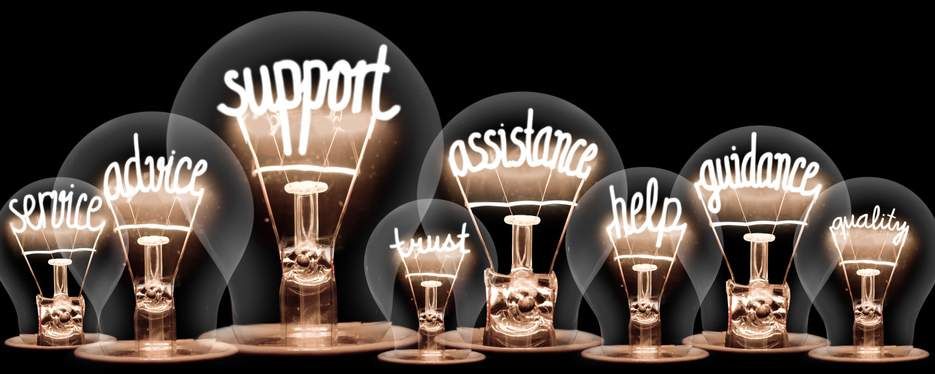Help Lightning Blog
5 Ways To Improve Customer Retention Rates

When looking to improve customer retention rates, it’s important to view this business objective through the lens of value first. How can you provide more value to your customers leaving them delighted and engaged? How can you blow your competitors out the water and become the one and only choice for them in a market with several, if not many, different products and providers?
Whether your company works on a B2B or B2C model, the takeaway is the same: customer retention matters, and it directly impacts your bottom line. After all, keeping a customer is 5x more lucrative than gaining a new one. And on top of that, research suggests that a mere 5% uptick in customer retention levels yield a 25-95% increase in profits (this could be due to the fact that the success rate of selling to an existing customer is 60-70% more likely than selling to a new customer). And at the end of the day, that’s increased positive cash flow that almost exclusively travels to your bottom line.
So the question becomes not if you should focus on customer retention as a matter of critical growth and importance, but how to improve customer retention levels, starting as soon as possible.
What’s On The Line
Although evidence suggests loyal customers are 5x as likely to forgive a mistake made by a company, the fact is that not all customers are so lenient. In fact, American Express found that ⅓ of customers will consider switching companies after just one instance of poor customer service.
So we know that companies don’t have that many chances to get it right (technically, they have less than one chance to make a good impression, if they don’t want to gamble 33% of their customers jumping ship). In that case, what are the influences that improve customer retention rates? And more importantly, what could be the critical pitfalls that could send them packing?
What Customers Care About
Negative emotions are powerful motivators when it comes to switching.
Hot Jar exemplified this point clearly in a recent study they conducted regarding the most frustrating occurrences in the customer life cycle.
The top 3 frustrations that businesses found among their customers was the following:
- Long wait/response times
- Employees who do not understand customer needs
- Issues and questions that went unanswered or unresolved
None of these grievances are surprising in the least. In fact, you could say that all these issues boil down to a lack of commitment to following the golden rule. Treat others as you would like to be treated. Working in conjunction with this, customers also expect to be rewarded for their loyalty. And they expect businesses to care about their repeat business.
Notice how none of the top grievances are around product quality or one-off mistakes. Arguably, these points of contention are forgivable in most customers’ minds.
What is unforgivable? Bad customer service.
Now, this isn’t to say customers won’t stop being customers if they consistently receive faulty products or low-quality services. But it does mean that issues can be smoothed over with quality, empathetic interactions between a business and its base.
So let’s discuss how you can improve customer retention metrics through the lens of stellar customer service.
5 Ways to Improve Customer Retention Rates, Starting Today
Offer quicker response times
This is a no-brainer – no one likes to hang on hold for 30 minutes. But for many businesses outgoings and overhead costs are a heavy consideration, and so balancing cost-effectiveness against customer satisfaction is a tricky objective.
As such, the question of how long your customers will wait patiently before getting annoyed or frustrated is industry specific. It may take some experimentation: for instance, in a retail setting a wait of more than 10 minutes is considered unacceptable. On the other hand, many patients don’t blink an eye when they wait in a dentist’s office for 15 minutes and up.
It also depends on the channel: for instance, 67% of B2B customers expect an email response time within one hour.
For all intents and purposes though, it’s best to keep call wait times under 20 minutes. Email communications should be within 24 hours, depending on the urgency of the request.
Also keep in mind that while lagging response times can trigger negative emotions, quick response times do the opposite: they make customers feel valued, heard, and increase loyalty to your company. As such, expedient, quality customer interactions should be top of the list when looking to improve customer retention overall.
Invest in more educational content
Again, this can vary by industry and your avatar, but if you’re looking to build your brand while offering customers value: consider offering your customers value every step of the way.
For instance, segmenting your base by service/product and industry, you can make some pretty strong assumptions about their main pain points and needs. You can provide them with free, high-value content (through newsletters, blog posts, white papers, and so on) to show that you care. And that you hold their needs in high esteem, inside and outside of traditional channels of communication.
Bonus here: when you routinely check in with customers through direct marketing means, you’re likely to not only improve customer retention rates, but also take front of mind. Especially when it comes to word of mouth referrals or potential upsell opportunities, as you’re fresh in their consciousness.
Train more attentive and communicative employees
At a minimum, all customer service representatives should be respectful, positive, and helpful. And if they go out of their way for customers, even better.
Since customer service representatives are the ‘face’ of a business, it’s important to put your best foot forward. After all, just one positive interaction yields excellent ROI for your business. In fact, 75% of people report they’d return to a business with good customer service. On the flip side, after a negative customer experience, on average 89% of consumers will begin doing business with a competitor.
Interestingly, one way to ensure your customers have a better experience? Ensure that your employees are happy in their jobs. On average, highly engaged employees have a 10% increase in customer satisfaction ratings than comparable employees who are unhappy in their jobs.
Personalize touch points
Every customer wants to feel like they matter. But according to recent research, this is especially the case for B2B customers, with 74% reporting that personalized interactions have a moderate to major influence on their loyalty.
This is a jump of 9% from B2C consumers. But in both markets you see that the vast majority of individuals – regardless of the industry in question – are increasingly expecting their providers to know their problem, history with the company, and pain points within minutes of a conversation taking place.
What does this mean for your business, then? Well, customer relationship management (CRM) systems may be more important than ever. And to really make the most of the CRM system you choose, logging call notes, recording conversations with customers. These along with implementing feedback should all rank high on your priority list. This will develop a screenshot view of a customer and their history (available to your customer service representatives) within seconds of connecting.
Offer remote first service
Omni-channel support is more important than ever.
According to Hubspot, in an age in which 50% of customers surveyed report feeling frustrated with automated response systems, 43% find it difficult to speak to an agent, and 33% are frustrated with the amount of time it takes to reach an agent, the environment for your business to differentiate itself by offering not only options, but quality customer service channels, is ripe.
One such way to offer highly interactive, engaging, and empathetic customer service is by offering remote first service.
Remote first service, aka remote support software, entails leveraging AR-enabled technology to more easily resolve customer problems in a shorter period of time. Essentially, this SaaS technology allows customer service representatives to essentially be on site with a customer, via video communication. This is alongside the ability to point, draw, and move objects on the ‘shared reality’ screen.
Remote first service is ideal for reducing customer frustration, increasing customer retention, and improving average handle time (AHT), all in one go.
Check out the various use cases for remote assistance software delivering remote first service. These range from expedited employee onboarding to lowered overhead costs, environmental benefits, and more.












